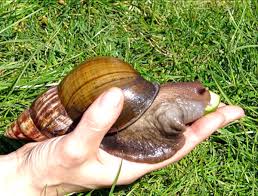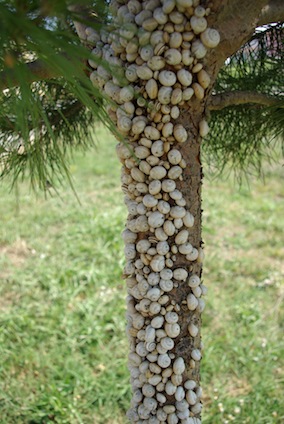Snails are gastropod mollusks; members of the phylum Mollusca and the class Gastropoda. Snails are a huge part of the diet in many parts of Africa, although they are not always affordable and available all year round. Their high protein, low fat and cholesterol content make them a nutritional favourite.
Snails contain almost all the amino acids needed by the body and most of its by-products are used for cosmetics and medicines.
As our population becomes more interested in healthier living and low-cholesterol diets, snails will become a popular alternative to to all the fatty and non-healthy meats that flood our markets nowadays. They are much cheaper than red meat with greater health benefits on top!
Snails have, for a long time, been a popular and recurring item on the menus of hotels, restaurants and bars where they often feature as boiled, fried and spiced kebabs. They are also a great addition to soups and stews which are a significant part of most African dishes.
Humans have been consuming snails for thousands of years. Snails are very high in proteins, iron, and water, while being low in fat. Snail consumption is popular in various countries around the world.
Currently, the global snail farming or heliciculture industry achieves sales of greater than $12 billion annually. Let’s take a closer look at the consumption of snails and the basics of starting a snail farm.
Countries known for eating and cultivating snails (Helix Pomatia)
Snail consumption and cultivation are popular to varying degrees in France, the U.S., Turkey, China, Indonesia, Italy, Spain, as well as African countries including Algeria, Cote d’Ivoire, Nigeria, and Ghana. In France, the delicacy known as escargot is an actually cooked snail. Escargot is very popular in many parts of Europe as well.
Read Also: How to Prevent other Predators in a Snail Farm
Below are the facts about snails and snail Farming:
Facts about Snails and Snail Farming
- Snails produce a thick slime which protect and give them the ability to crawl on sharp objects like the edge of a razor and not get hurt.
- Snails are hermaphrodites that is to say that they posses both male and female reproductive system.
- Garden snails have up to 14,175 teeth and they are all located on their tongue called the radula.
- The biggest snail specie is the Achatina Marginata (AM) which is very popular in Africa.
- Snails have the ability to hibernate or aestivate during extreme cold or dry season. They form a protective white covering which can sustain them for months.
- Snails are nocturnal animals that is to say they are more active at night than during the day.
- Snail is a very good source of protein
- Due to the suction created by their slime, a snail can crawl upside sown.
- Snails are deaf, they can only see, feel and smell.
- Snails can live up to 20 years like in some cases that have been seen.

Read Also: General Routine Maintenance Practices of Snail
Additional Snail Facts
According to research, the following are some additional snail facts:
1) Some snails Hibernate
Some species of snails hibernate during the colder months of the year. They cover their bodies with a thin layer of mucus, which prevents them from drying out.
Sometimes snails also do a similar process in the summer, called estivation, to survive if it is a dry period. These processes are probably one of the reasons they have survived for millions of years.
2) Snails can have a long life
The life expectancy of snails depends on their habitat and the species. Some of them only live for about five years. However, others in captivity can live up to 25 years old.
3) There are giant snails
The biggest land snail recorded was 12 inches long and weighed near 2 pounds. It was a Giant African Snail. Other species are tiny being only a few centimeters long when they are adults and just a couple of ounces in weight.
4) Snail Moving
When moving, snails leave behind a trail of mucus. This mucus acts as a lubricant to reduce friction against the surface where they pass.
5) Snail Mucus
It is a myth that snail mucus can make humans ill. Many people worry that the snails in their garden will ruin the foods grown there and make them unfit for consumption, but that is false.
6) Snails live in slow motion
Garden snails (Helix apersa) reach a top speed of 50 yards per hour; this is about 0.5 inches per second. While they don’t move fast, they do move at a very steady pace. Snails are one of the slowest creatures on the Earth.
7) Snails are Hermaphrodites
Snails have the reproductive organs of both, males and females, which categorize them as hermaphrodites. However, they usually do not create offspring on their own. They mate with another snail, and then both lay eggs.
Read Also: Predators, Parasites and Diseases of Snail
8) Snails can see but can’t hear
Most land snails have two set of tentacles, the upper one carry the eyes, while the lower one has the olfactory organs. However, they do not have ears or ear canal.
9) Snails are nocturnal
Snails are nocturnal animals, which means most of their activities take place at night.
Snails don’t like the sunlight, which is why you find them out more on cloudy days. If you keep them in an aquarium, make sure that there is not too much sunlight in the room, or the snails will stop eating and hide inside their shell.
10) Get your size
Snails length ranges from a few centimeters to 12 inches.
11) Snail Care
Snails will die if you put salt on them. Make sure they are not in contact with salt if you have one in captivity because their body can´t process it.
12) Very Hungry
The Giant African Land Snail is known to eat more than 500 different types of plants.
13) Small, not weak
Snails are strong and can lift up to 10 times their body weight in a vertical position.
14) Large family
There are at least 200,000 species of mollusks out there including snails, although only 50,000 are classified.
Read Also: Seasonal and Daily Management Practices for Snail
Read Also: Is Cucumber Farming Profitable?
Frequently Asked Questions
We will update this section soon.
